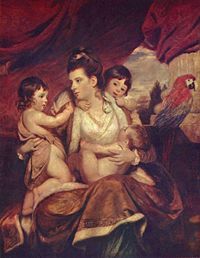Sibling rivalry
Sibling rivalry is a type of competition or animosity among brothers and sisters, blood-related or not. It is a predictable, normal and healthy response of an older child to the birth of a new brother or sister because the older child feels threatened by the new member of the family.
Origins
80% of people in Western countries have at least one sibling, and siblings generally spend more time together during childhood than they do with parents. The sibling bond is often complicated and is influenced by factors such as parental treatment, birth order, personality, and people and experiences outside the family.
Children are sensitive from the age of one year to differences in parental treatment. From 18 months on siblings can understand family rules and know how to comfort and hurt each other. By three years old, children have a sophisticated grasp of social rules, can evaluate themselves in relation to their siblings, and know how to adapt to circumstances within the family.[1]
Sister/sister pairs are the closest and brother/brother pairs are the most rivalrous, more so when they are closer in age, with identical male twins the most competitive of all. Parental and societal expectations of males may lead to more competitiveness and a greater degree of comparison between brothers, as opposed to between sisters or opposite-sex siblings.
Sibling relationships can change dramatically over the years. Events such as a parent’s illness may bring siblings closer together, whereas marriage may drive them apart, particularly if the in-law relationship is strained. Approximately one-third of adults describe their relationship with siblings as rivalrous or distant. However, rivalry often lessens over time and at least 80 percent of siblings over age 60 enjoy close ties.[2]
Animals
Sibling rivalry is common among various animal species, in the form of competition for food and parental attention. An extreme type of sibling rivalry occurs when young animals kill their siblings, as often happens among eagles and hyenas.[3]
Sibling relationships in animals are not always competitive. For example, among wolves, older siblings help to feed and guard the young.[4]
Causes
The process, known as dethronement[5] occurs when the older child feels they must now share their love with someone else. It is not initially hatred but a sense of unsettlement and grieving over the loss of position as the parent's sole object of love and attention. In his book, Seymour Reit[6] says that among children the deepest need, the greatest hunger, is to receive love from their caretaker. Because of this dependence, young siblings sometimes fear that love given by parents to others will mean love withheld from themselves. The firstborn's reaction to the birth of a new sibling is a change in behavior that is either aggressive ore regressive. Typical aggressive behaviors include hitting, pinching, attempting to lift the baby off the parent's lap, covering the baby with a blanket to name a few. Regressive behaviors include problems with toilet training or bedwetting, using a bottle for feeding after being weaned, thumb sucking or use of a pacifier, temper tantrums, demanding behavior or clinging.
The story of Cain and Abel, written in the Bible at Genesis 4, in the Torah, and Qur'an at 5:27-32, tells of the first human murder when Cain killed his brother Abel. They were the sons of Adam and Eve and the murder a result of their Fall. Many religious faiths view this as the prototypical murder and paradigm for conflict and violence. While some view this story as merely a story of the origin of humanity, and others as a justification of murder, it is generally interpreted as a tragedy in human relationships. Cain and Abel often represent different personality types or social positions. Cain represents the firstborn, sinful, worldly, privileged, a farmer, a city-builder and bad son. Abel represents the junior, faithful, spiritual, herdsman, and good son.
Social psychologists would view Cain's action as an example of the frustration-aggression hypothesis and advocate teaching non-violent responses to frustration. Unificationists teach that God equally loves both sons and desires the reconciliation of Cain and Abel. The resolution of Cain-Abel conflicts is a model for peace and conflict resolution generally.
Psychoanalytic view
Sigmund Freud, founder of psychoanalysis, saw the sibling relationship as an extension of the Oedipus complex, where brothers were in competition for their mother's attention and sisters for their fathers.[7] Alfred Adler saw siblings as "striving for significance" within the family and felt that birth order was an important aspect of personality development. David Levy introduced the term "sibling rivalry" in 1941, claiming that for an older sibling "the aggressive response to the new baby is so typical that it is safe to say it is a common feature of family life."[8]
Evolutionary psychology view
Evolutionary psychologists often explain sibling rivalry in terms of parental investment and parent-offspring conflict. Parents are inclined to spread their resources over all their children, whereas a child would like all those resources to himself. So the parent tries to encourage the children to share, but often meets resistance. Children share half of their genes with siblings, so they have some motivation to feel positively towards brothers and sisters. This may explain the mixed feelings that siblings sometimes have towards each other.[9]
Decreasing sibling rivalry
According to the Systematic Training for Effective Parenting (STEP) Program, the key to decreasing sibling rivalry lies in making each child feel valuable, important, and a cherished member of the family.
- People are decision-making social beings whose main goal in life is to belong. Each of us strives continually to find and maintain a place of significance. Choosing how you belong is a powerful motivation![10]
Through the parents' love for his brothers and sisters, a child learns to love them as well. A son's respect for his sister is learned by observing the parents' respect for her; a daughter's respect for her brother is likewise learned. The parents love endows each child with value that is worthy of respect. This is the starting point for children to learn empathy, caring, sharing and giving:
- Sibling rivalry can be a major spur in children's learning to live together, learning how to share, how to win victories and suffer defeats, how to love and how to cope with their own unloving feelings.[11]
From this perspective, sibling rivalry is not a negative situation, but an important lesson in life. Brazelton goes on to explain that failure to learn these lessons in childhood may make it more difficult, and more emotionally costly, to learn them as an adult.
Raising Children of Peace [5] advocates that parents not try to eliminate rivalry, but to keep it within healthy and constructive bounds. It further explains that the biblical story of Cain and Abel does not mean the rivalry evil, but rather the brothers merely desired to win approval, attention and recognition from God (as children from a parent) for their offerings. Evil prevailed only when Can chose to act on his resentful and jealous feelings. It is possible to resolve these feelings, as demonstrated in another Biblical story of Jacob and Esau. Jacob was able to win his brother's heart and heal Esau's resentment. The desire for love and attention is not wrong, it is a natural desire.
With this in mind, parents can use several tools to help decrease sibling rivalry with the intention that each child is valuable, important and cherished regardless of their behaviors.
- Ignore tattling.
- Decrease competition and never compare one sibling to another.
- Encourage older siblings to help younger siblings so they feel responsible and needed.
- Allow children to express their feelings constructively, without blame.
- Don't get involved in arguments of "who started the fight." Separate the fighters and reinforce the rule of "no hitting."
- Sharing can be encouraged but not forced. Each child needs their own privacy respected.
- Individually value and spend time with each child and respect the uniqueness of each child to lessen the degree to which children feel they need to compete for your love.
Famous examples of sibling rivalry
The Bible contains many examples of sibling rivalry:
- Cain and Abel
- Jacob and Esau
- Leah and Rachel
- Joseph and his brothers
- Moses and his brother and sister
The complex relationship between siblings has provided a rich source of material for fiction:
- King Lear (Shakespeare): Goneril, Regan, and Cordelia; Edmund and Edgar
- The Taming of the Shrew (Shakespeare): Katherine and Bianca
- Sense and Sensibility (Jane Austen): Elinor and Marianne Dashwood
- East of Eden (John Steinbeck): Cal and Aran Trask
- The Godfather (Mario Puzo): Sonny, Fredo, and Michael Corleone
Real life examples of sibling rivalry include:
- Olivia de Havilland and Joan Fontaine
- Ann Landers and Abigail Van Buren
- Christopher and Peter Hitchens
Notes
- ↑ Judy Dunn and Carol Kendrick, Siblings: Love, Envy, and Understanding , (Harvard University Press, 1982 ISBN 0674807359)
- ↑ Jane Mersky Leder, "Adult Sibling Rivalry" Psychology Today, Jan/Feb (1993) Retrieved July 6, 2007.
- ↑ Frank J. Sulloway, Birth Order, Sibling Competition, and Human Behavior, in Conceptual Challenges in Evolutionary Psychology: Innovative Research Strategies, edited by Paul S. Davies and Harmon R. Holcomb (Dordrecht and Boston: Kluwer Academic Publishers, 2001), pp. 39-83. Retrieved July 6, 2007.
- ↑ Mothers and Others Retrieved July 6, 2007.
- ↑ 5.0 5.1 ,Betsy and Farley Jones, Children of Peace, (Holy Spirit Association, 1997 ISBN 0910621845) Cite error: Invalid
<ref>tag; name "jones" defined multiple times with different content - ↑ Seymour Reit, Sibling Rivalry, (Ballantine Books 1988)
- ↑ Juliet Mitchell, Freud lecture: A matter of life or death: siblinghood and the unconscious. Retrieved July 5, 2007.
- ↑ David M. Levy, The Hostile Act, First published in Psychological Review, (1941), 48, 356-361. Retrieved July 6, 2007.
- ↑ Annie McNerney and Joy Usner, Sibling Rivalry in Degree and Dimensions Across the Lifespan. Retrieved July 5, 2007.
- ↑ Don Dinkmeyer and Gary C. McKay, STEP (Systematic Training for Effective Parenting)-The Parents Handbook, (American Guidance Service, Minnesota, 1989 ISBN 978-0785411888)
- ↑ T. Berry Brazelton, Understanding Sibling Rivalry: The Brazelton Way, (Da Capo Lifelong Books; 1st Da Capo Press Ed edition, 2005 ISBN 978-0738210056)
ReferencesISBN links support NWE through referral fees
- Devine, Tony, Joon Ho Seuk and Andrew Wilson (Eds.) 2000. Cultivating Heart and Character: Educating for Life's Most Essential Goals. Character Development Foundation. ISBN 1892056151
- International Educational Foundation. 2006. Educating for True Love. International Educational Foundation. ISBN 1891958070
External links
- How to stop sibling rivalry by Virginia K. Molgaard
- Sibling rivalry: You vs. Them
- Living with your teenager: Dealing with Sibling rivalry
- Sibling Rivalry by William Antonio Boyle, Ph.D.
- Sibling Rivalry in Kids Health
- Your Child: Development and Behavior Resources
Credits
New World Encyclopedia writers and editors rewrote and completed the Wikipedia article in accordance with New World Encyclopedia standards. This article abides by terms of the Creative Commons CC-by-sa 3.0 License (CC-by-sa), which may be used and disseminated with proper attribution. Credit is due under the terms of this license that can reference both the New World Encyclopedia contributors and the selfless volunteer contributors of the Wikimedia Foundation. To cite this article click here for a list of acceptable citing formats.The history of earlier contributions by wikipedians is accessible to researchers here:
The history of this article since it was imported to New World Encyclopedia:
Note: Some restrictions may apply to use of individual images which are separately licensed.


